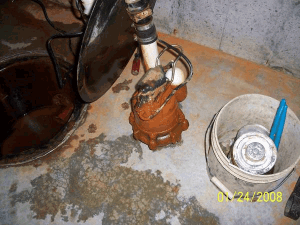Iron Bacteria – Bad for pipes, pumps & well equipment but good for the environment?
May 12, 2014
What are iron bacteria? 
Iron bacteria are actually tiny living organisms. These iron bacteria live in and occur in soil, shallow groundwater, and also surface waters. The bacteria oxidize iron, and also oxidize manganese if available. The result of the oxidization is deposits of what appear to be “rust”.
Bacterial cells and a nasty slimy material also form and will stick on well pipes, pumps, and plumbing fixtures. While they are not known to cause disease and are not harmful to human or animal health, iron bacteria cause ugly stains, give water a horrible taste and produce rotten odors.
One of the biggest problems with iron bacteria is that the growth will affect how plumbing performs and how much water will flow from a well and through pipes.
Iron Bacteria can build up on sump pump equipment and drainage lines as well as well pipes and other plumbing or piping that comes in contact with ground water.
Rescon Basement Solutions will service a customer’s sump pump and pumping/plumbing equipment if the customer notices any signs of iron bacteria. Using a specialized Hot Flush treatment, we can ensure that your pumping systems run free and smoothly once again.
On the bright side – Scientists are experimenting and Iron-oxidizing bacteria may be fooled into ‘eating’ electrons instead.
An article published on Mother Nature Network last year spoke about researchers harnessing iron bacteria to create energy and eat carbon dioxide.
“Scientists have long been interested in the unique properties of iron-oxidizing bacteria, and now, new research has paved the way to cultivate these bacteria using electricity instead of iron.
Researchers added a marine iron oxidizer along with nutrients to an electrode tuned to provide electrons at the same level as dissolving iron would provide. The idea was to “fool the bacteria into thinking they’re at the world’s best buffet,” Bond said.
And fooled they were. The bacteria multiplied and formed a film on the electrode, and eventually the researchers were able to grow the bacteria with no iron in the medium, proof that the bacteria were living off the electrons they absorbed from the electrode to capture carbon dioxide and replicate.
The new method, called electrochemical cultivation, gives the bacteria a steady stream of electrons — instead of iron — that the bacteria can use to “breathe.” The work was published on Jan. 29 in mBio, the journal of the American Society for Microbiology.”
